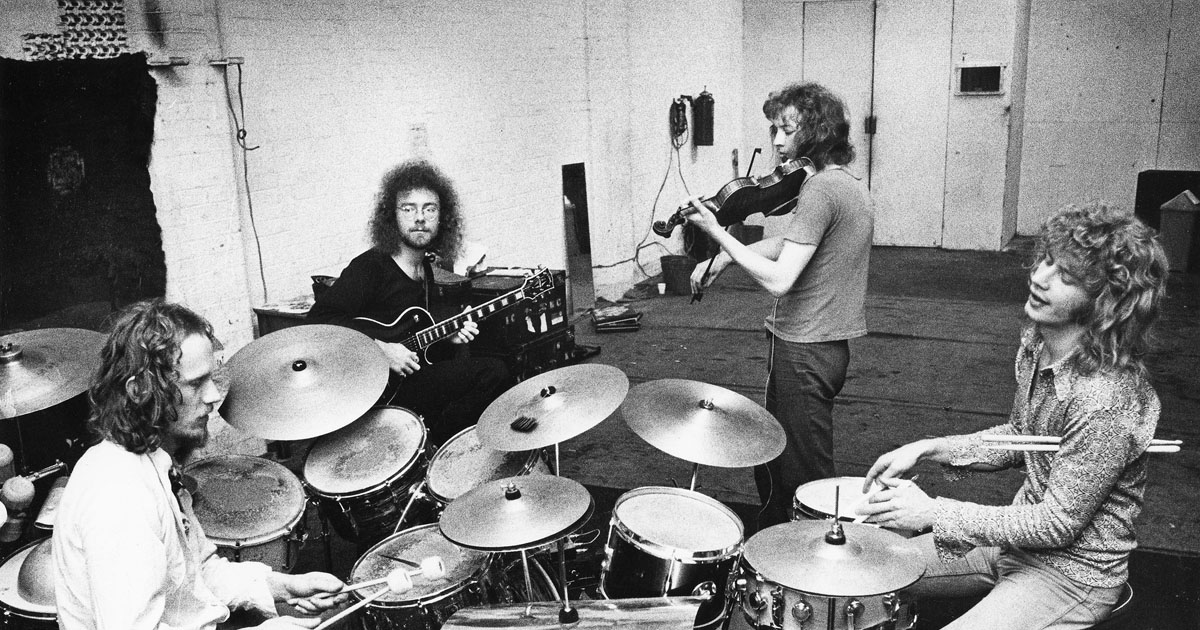Jamie Muir: The Sonic Alchemist of King Crimson Passes at 82

King Crimson: Jamie Muir, Robert Fripp, David Cross, Bill Bruford Image by Barrie Wentzell
Jamie Muir, the wildly inventive percussionist whose untamed creativity shaped King Crimson’s Larks’ Tongues in Aspic and whose work in the British jazz and free-improv scene pushed the limits of sound, passed away on February 17, 2025, at the age of 82.
Muir wasn’t just a drummer, he was a sound sculptor, a shaman of rhythm who treated percussion as a force of nature. Born in Edinburgh in 1942, he took an unconventional path, starting with jazz and free improvisation before diving headlong into a world where anything—from scrap metal to chains to the human voice—could become an instrument.
 His time in the avant-garde jazz collective The Music Improvisation Company set the stage for his radical approach. But it was in 1972, when he joined King Crimson, that his singular vision reached a wider audience. On Larks’ Tongues in Aspic, Muir unleashed an unpredictable, almost ritualistic energy, blending traditional percussion with sheer chaos, clanking, scraping, and smashing his way through Crimson’s intricate compositions. His stage presence was equally unpredictable: leaping, howling, covered in paint, and fully immersed in the moment.
His time in the avant-garde jazz collective The Music Improvisation Company set the stage for his radical approach. But it was in 1972, when he joined King Crimson, that his singular vision reached a wider audience. On Larks’ Tongues in Aspic, Muir unleashed an unpredictable, almost ritualistic energy, blending traditional percussion with sheer chaos, clanking, scraping, and smashing his way through Crimson’s intricate compositions. His stage presence was equally unpredictable: leaping, howling, covered in paint, and fully immersed in the moment.
Then, just as suddenly as he arrived, Muir vanished. In 1973, after an onstage injury (or perhaps a spiritual revelation) he walked away from the rock world and into a Buddhist monastery in Scotland. While his time in King Crimson was brief, his influence on the band—and on drummers like Bill Bruford—was immense. Bruford credited Muir as “my biggest influence and the guy who turned my head totally around.”
He also influenced Yes singer, Jon Anderson who said “he changed my life.”
From Wikipedia:
He strongly recommended that Anderson read Paramahansa Yogananda‘s Autobiography of a Yogi. He said to me, ‘Here, read it,’ and it started me off on the path of becoming aware that there was even a path … Jamie was like a messenger for me and came to me at the perfect time in my life … he changed my life.” Anderson’s fascination with the book soon led to the creation of the Yes album Tales From Topographic Oceans.[11]
Muir reemerged in the ‘80s, dabbling in collaborations with Derek Bailey and Evan Parker, but his musical output remained elusive. In later years, he turned to painting, trading sonic abstraction for visual expression.
Jamie Muir was an artist who lived by his own rules, never settling, always searching. His music wasn’t just played—it was experienced. And while he may have left the stage long ago, the echoes of his wild, untamed rhythms will continue to resonate.
—John Diliberto, Echoes
